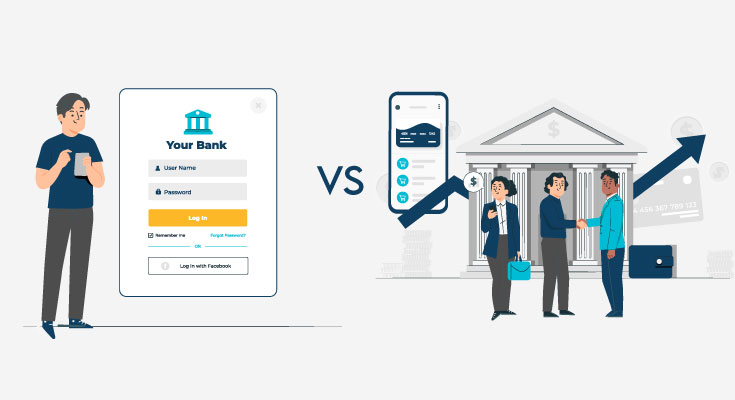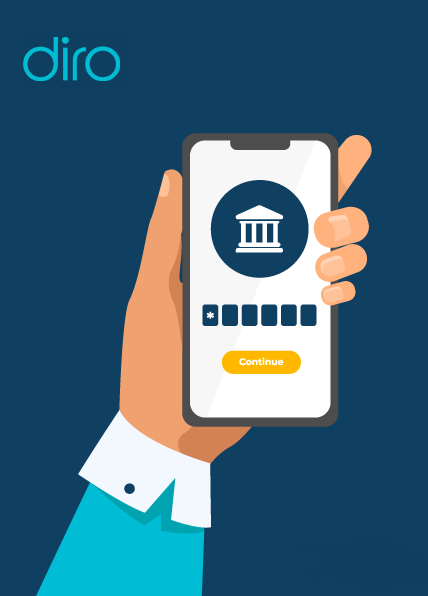NeoBanks vs Traditional Banks – What’s the Difference?

Have you noticed new companies popping up out of nowhere, offering great credit cards, bank accounts, and other financial services? Companies with a massive digital footprint but almost zero physical footprints.
Welcome to the world of digital banking. Digital banking or Neo-Banking is the next natural step that the financial industry will take, at least according to some industry experts.
Every now and then, there’s someone who asks what digital banks are, how they operate, and how Neobanks are different from Traditional banks.
The word Neo comes from a Greek word that basically translates to “new.” So, Neobanks is a clever way of saying that this is the new age of banking. Similar to traditional banks, they offer savings accounts, current accounts, loans, money transfers, credit cards, and more.
So what’s the actual difference between the two? That’s what we’ll help you figure out.
Quick Overview of Traditional Banks vs Neobanks
| Comparison Factors | Neobanks | Traditional Banks |
|---|---|---|
| Physical Branches | No physical presence | Physical branches and ATMs |
| Fees/Rates | Very low or no fees at all. High-end rates on deposits | Multiple fees for different services. Lower rates on deposits |
| Products/Services | Usually focused on one particular financial service | Complete banking service |
| Customer Service | Support is available online, in person, and on the phone | Support is available online, in person, on the phone |
| Tech Features | Leverages advanced technologies | Slower adoption of new technologies |
| FDIC Insurance | Only online support is available | FDIC insured |
| Target Audience | Available if partnered with an FDIC-insured bank | Almost every kind of individual and business |
What Are Traditional Banks?
Traditional banks are the brick-and-mortar institutions that offer physical banking & non-banking services. Most traditional banks have decades of experience under their belt and have multiple branches in towns and cities. Traditional banks offer these services:
- Bank account opening & closing
- Locker facilities
- Money transfer services
- Loans and investments
- Credit cards
- Cash withdrawal through ATMs
Pros of Traditional Banks:
- Comprehensive banking services
- In-person customer services offer better guidance
- Established reputation and trust
- Wide network of ATMs for cash disbursal
Cons of Traditional Banks:
- Legacy systems don’t offer the flexibility tech-savvy customers want
- Higher fees for various services & account maintenance
- Service processing times are slower than those of Neo banks
- Customers have to visit physical branches to get things done
Key Features of Traditional Banks:
1. Physical Presence
Traditional banks have several branches across multiple cities. Customers can access financial services from their bank at any of the branches. Also, customers who want in-person assistance, traditional banks are the best option.
2. Wide Range of Financial Services
Traditional banks, unlike Neo banks, offer a wide range of financial services. Banks provide a range of services, such as loans, credit cards, investment services, foreign exchange, locker services, and more.
3. Regulatory Oversight
Traditional banks have to operate under rules and regulations set by their governing bodies. This ensures that banks offer financial stability and work towards protecting depositors and financial information.
4. Customer Service & Relationships
Traditional banks offer in-person customer service at all their branches. This makes customers feel safe. In-person experience also offers cultivate long-term relationships with their customers, offering personalized service & financial advice.
What are NEO Banks?
Neo banks are the banks of the technological era. Their primary mode of offering banking services is online. Neo banks don’t have any offline branches; all banking services offered can be accessed via a website or an app. Customers choose Neo banks over traditional ones because of the flexibility and agility they offer.
Common Neo bank services include:
- Bank accounts
- Credit cards
- Loans and investments
- Money transfer services
Pros of Neo Banks:
- Lower fees or minimal fees for transactions, account maintenance, and other financial services
- Neo banks offer higher interest rates compared to traditional banks
- More convenient and accessible because of their online mode of operation
- Fast and streamlined account opening
- Ideal for tech-savvy users who want financial services at their fingertips
Cons of Neo Banks:
- No physical branches, so there’s a lack of in-person guidance
- Neo Banks offer limited financial services compared to traditional banks
- Not suitable for non-tech-savvy users; moreover, technical issues can cause a complete stoppage of services
- As Neo banks are primarily digital, there may be concerns regarding the security of financial and personal information.
Key Features of Neo Banks:
1. Digital-First Approach
Neobanks offer better flexibility and accessibility to financial services for users of all kinds because of their digital-first nature. Customers can access financial services through mobile apps and web platforms, making it easy to access financial services.
2. User-Friendly Interfaces
As they are digital-first, Neo banks often offer user-centric design that makes accessing financial services easy.
3. Personalized Services
Neobanks offer more personalized banking services and experiences to customers as they rely on AI & data analytics. Common personalized services include:
- Tailored saving plans
- Budgeting strategies
- Customized financial tools
4. Lower Cost
As Neo banks don’t have physical branches, overhead costs, Neo banks offer more affordable banking services compared to traditional banks. This can make them an attractive option for users who want to save money.
The Banking Landscape in the Digital Age
Technology, especially the rise of smartphones, has completely changed the banking landscape in recent years. Traditional banks, while still relevant, are facing serious competition from Neobanks.
Neo banks are offering faster, more seamless, and more affordable banking services compared to traditional banks. The banking sector is heading towards a major digital-first shift, with both Neo Banks and Traditional Banks fighting for a place at the top.
Difference Between Neobanks and Traditional Banks
There’s a huge list of similarities between Neobanks and traditional banks, but they’re still fundamentally different. Let’s go over the list of differences between Neobanks and traditional banks.
Neo Banks are slowly but steadily shaping the financial landscape, impacting traditional banks and how they have been operating in the past. Let’s take a look at the key differences between Neo Banks and Traditional banks.
1. Neobanks have no physical presence
Unlike traditional banks that have branches all over a location, neobanks have no physical locations you can visit. The entire infrastructure is online, and you can handle every setting of your account with an app.
This online-only model helps in saving thousands of dollars on operational costs and costs that come along with running physical locations.
Traditional banks historically have had a physical presence, and in recent years, they’ve started to get into digital banking more deeply. Compared to digital banking services offered by traditional banks, Neobanks’ services are more user-friendly and easier to use.
2. Neobanks are not regulated
While they’re called banks, neobanks are actually financial institutions. The difference between neobanks and traditional banks is that traditional banks need to have banking licenses. Neobanks are not recognized as official entities by regulatory bodies, and thus, they don’t have to follow regulations.
They utilize this saved money to provide better services at a lower cost to customers.
Some neobanks may have partial, full range, or a special banking license. A banking license allows neobanks to offer all kinds of banking services.
3. Neobanks are more affordable
As neobanks have no physical operations to run, they can save more money, which allows them to be more affordable. They have no opening fees, low maintenance costs, no minimum requirements, no hidden fees, and they offer higher savings interest rates.
Neobanks also tend to be more transparent with their fees upfront. Traditional banks tend to have a lot of hidden charges that consumers may not understand at first.
4. Neobanks offer more flexibility
Compared to traditional banks, every single activity in neobanks is easier to do. Opening up a new account and signing up is far easier than with traditional banks. It is also easier to borrow money from a neobank compared to a traditional bank.
Signing up for a credit card or applying for a loan at a traditional bank means you’ll have to pass a range of checks.
5. Traditional banks have more services
The biggest difference between a neobank and a traditional bank is the number of services offered. While Neobanks are faster, more user-friendly, and flexible, they often have one or 2 main services.
Comparatively, traditional banks have a wider reach, all thanks to their physical locations. People who don’t yet trust online banking, or haven’t had exposure to online banking services, still prefer traditional banking over newer methods.
6. Traditional banks are more accessible
The popularity of Neobanks has grown tremendously over the years. This is because of those who want the convenience of online banking. At the same time, traditional banks use their old methods of maintaining quality relations with their customers.
Neobanks are going through a great phase throughout the world. Millions of customers rely on their services, and industry experts are waiting for the future. Currently, the situation is that more users prefer traditional banks over neobanks as they’re more easily available and more reliable.
Customers can actually go to a physical office or talk to a representative when they have a grievance. The same can’t be said for a neobank.
Similarities Between Neobanks and Traditional Banks
While Neobanks and traditional banks are fundamentally different, there are some similarities between the two:
- Account types: Both Neobanks and traditional banks offer basic banking services like checking & savings accounts.
- Online and Mobile banking: Similar to Neobanks, traditional banks have also started offering online and mobile banking.
- Security: Both Neobanks and traditional banks invest in state-of-the-art safety infrastructure to keep customer data safe.
Frequently Asked Questions
1. Which bank is better? Neobank or traditional bank?
The better bank depends on your needs. Based on your service requirements, the better bank for you can differ greatly. Neobanks have lower fees, they’re easier to sign up with, and they’re great for tech-savvy people.
Traditional banks are more reliable, have physical accessibility, and are regulated. But they’re more expensive, offer lower interest rates, and more.
2. What are the services of a traditional bank?
The most common traditional banking services include:
- Providing a savings account
- Providing a checking account
- Issuing debit cards
- Issuing credit cards
- Wealth management
- Giving out loans
- Insurance
3. Which bank is safer, a Neobank or a Traditional bank?
It comes down to the level of due diligence an institution has employed. Being more tech-friendly, neobanks generally offer better security. They have simpler onboarding, yet they do ID verification and KYC checks.
However, traditional banks have huge infrastructure and years of experience under their belts. Moreover, they have to follow regulations set by regulatory bodies.
In the end, it comes down to the level of customer due diligence an institution employs.
4. Do Neobanks have banking licenses?
No, most neobanks don’t have a banking license. Although there are chances that some neobanks may have a partial, full, or special banking license. With these licenses, neobanks can offer services that a traditional bank can, with more focus on user experience and affordability.













